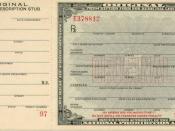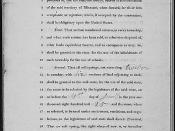"No person shall, on or after the date when the 18th Amendment to the Constitution of the United States goes into effect, manufacture, sell, barter, transport, import, export, deliver, furnish or possess any intoxicating liquor except as authorized in this act" (Title II, Section 3 National Prohibition Act). At midnight on January 16th, 1920 the 18th Amendment to the Constitution was put into action, and the United States of America went dry. Under the Volstead Act, passed in October of that same year, any beverage with over .5 percent alcohol was considered intoxicating, and therefore forbidden under the 18th Amendment. Almost immediately breweries, distilleries, and saloons closed their doors. Many people believed that alcohol created a disorderly society of people without morals, and even before the 18th Amendment was ratified, about 65 percent of the country had already banned alcohol. In 1916, seven states adopted anti-liquor laws, bringing the number of states prohibiting the manufacture and sale of alcoholic beverages to 19.
Drunkenness was blamed for family breakdown, crime, poverty, and violence and the government set out to put people on the right path in the creation of the national prohibition act (Craats 20). While prohibition was created to prevent the downfall of society, it was ineffective since it was unenforceable and in opposition to its purpose, it lead to a society of organized crime, increased alcohol consumption, lawlessness and the degradation of morals that now classifies the 1920's culture.
"Organized crime infiltrated the ranks of federal agents and local police-all underpaid and overworked men who could not always resist the temptation and pressure of the wealth of organized crime" (Hanson 35). With salaries of only $2,300 a year, the prohibition movement was alluring to these men, and the result was an increase in graft and corruption of...


